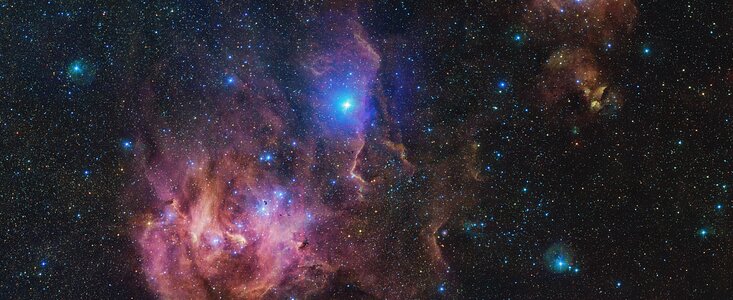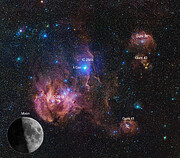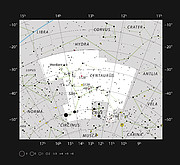Komunikat prasowy
Nowy obraz z ESO ma 1,5 miliarda pikseli i przedstawia niesamowite szczegóły Mgławicy Biegnący Kurczak
21 grudnia 2023
Różne świąteczne tradycje obejmują uczty z indyka, makaronu soba, latkes (rodzaj placków ziemniaczanych) lub Pan de Pascua (rodzaj ciasta), w tym roku Europejskie Obserwatorium Południowe (ESO) przynosi na święta kurczaka. Tzw. Mgławica Biegnący Kurczak to dom wielu młodych gwiazd będących w trakcie powstawania. Niesamowicie szczegółowo ukazuje ją obraz z 1,5-miliardem pikseli uzyskany przez VLT Survey Telescope (VST) w lokalizacji obserwacyjnej Paranal w Chile.
Ten ogromny gwiezdny żłobek znajduje się w kierunku konstelacji Centaura, około 6500 lat świetlnych od Ziemi. Młode gwiazdy w mgławicy emitują intensywne promieniowanie, które powoduje, że otaczający je gaz wodorowy świeci w odcieniach różowego.
Mgławica Biegnący Kurczak tak naprawdę składa się z kilku obszarów – wszystkie widać na zaprezentowanym zdjęciu, które rozciąga się na powierzchni na niebie odpowiadającej 25 tarczom Księżyca w Pełni [1]. Najjaśniejszy rejon w mgławicy to IC 2948, w którym niektóre osoby widzą kształt głowy kurczaka, a inni jego kuper. Delikatne pastelowe kontury to eteryczne pióropusze gazu i pyłu. Bardziej w stronę centrum obrazu znajduje się jasna, pionowa, niemal słupowa struktura – IC 2944. W tym konkretnym rejonie najjaśniej błyszczy Lambda Centauri, Gwiazda widoczna nieuzbrojonym okiem, znajdująca się zncznie bliżej nas niż sama mgławica.
W IC 2948 i IC 2944 jest wiele młodych gwiazd, przy czym o ile mogą one być jasne, to z pewnością nie są miłe. Wysyłają ogromne ilości promieniowania, kształtując otoczenia tak jak… kurczak. Niektóre rejony mgławicy, znane jako globule Boka, są w stanie przetrwać gwałtowne bombardowanie promieniowaniem ultrafioletowym przenikającym ten obszar. Jeśli powiększymy obraz, możemy je zobaczyć: małe, ciemne, gęste skupiska pyłu i gazu rozsiane po mgławicy.
Inne sfotografowane rejony obejmują, w prawej górnej części: Gum 39 i 40, w prawej dolnej: Gum 41. Oprócz mgławicy widać niezliczone pomarańczowe, białe i niebieskie gwiazdy, niczym fajerwerki na niebie. Ogólnie rzecz biorąc, na tym obrazie jest więcej cudów niż można opisać – powiększając i przesuwając zdjęcie można nacieszyć oczy.
Zdjęcie jest wielką mozaiką złożoną z setek osobnym klatek starannie zszytych razem. Poszczególne obrazy zostały uzyskane przez filtry, które przepuszczają światło o różnych kolorach, a następnie połączone, aby uzyskać końcowy efekt. Obserwacje prowadzono przy pomocy kamery szerokiego pola OmegaCAM na VST, teleskopie należącym do narodowego Instytutu Astrofizycznego we Włoszech (INAF), a znajdującym się w ESO w lokalizacji Paranal na chilijskiej pustyni Atakama, idealnie nadającej się uzyskiwania map nieba południowego w zakresie światła widzialnego. Wykorzystane dane stanową część przeglądu nieba VST Photometric Hα Survey of the Southern Galactic Plane and Bulge (VPHAS+). Projekt ten ma na celu lepsze zrozumienie cyklu życia gwiazd.
Uwagi
[1] Obraz od brzegu do brzegu ma 270 lat świetlnych. Przeciętny kurczak potrzebowałbym 21 miliardów lat, aby przebiec tę odległość. To o wiele dłużej niż istnieje Wszechświat.
Więcej informacji
Europejskie Obserwatorium Południowe (ESO) umożliwia naukowcom z całego świata na odkrywanie tajemnic Wszechświata z korzyścią dla nas wszystkich. Projektujemy, budujemy i zarządzamy światowej klasy obserwatoriami naziemnymi – których astronomowie używają do odpowiadania na ciekawe pytania i szerzenia fascynacji astronomią – a także promujemy międzynarodową współpracę w astronomii. Ustanowione w 1962 roku jako organizacja międzynarodowa, ESO jest wspierane przez 16 krajów członkowskich (Austria, Belgia, Czechy, Dania, Finlandia, Francja, Hiszpania, Irlandia, Holandia, Niemcy, Polska, Portugalia, Szwajcaria, Szwecja, Wielka Brytania oraz Włochy), a także Chile jako kraj gospodarz, oraz Australię jako strategicznego partnera. Siedziba ESO, a także jego centrum popularyzacji nauki i planetarium (ESO Supernova) znajdują się w pobliżu Monachium w Niemczech, natomiast chilijska pustynia Atakama – niesamowite miejsce z wyjątkowymi warunkami do obserwacji nieba – jest domem dla naszych teleskopów. ESO zarządza trzema lokalizacjami obserwacyjnymi w Chile: La Silla, Paranal i Chajnantor. W Paranal ESO posiada teleskop VLT (Very Large Telescope – Bardzo Duży Teleskop) oraz dwa teleskopy do przeglądów nieba. VISTA pracuje w podczerwieni, VLT Survey Telescope w zakresie widzialnym. W Paranal ESO zarządza także południowym obserwatorium CTA (Cherenkov Telescope Array South) – największym na świecie i najbardziej czułym obserwatorium promieniowania gamma. Wspólnie z międzynarodowymi partnerami ESO zarządza także radioteleskopami APEX i ALMA, które są instrumentami do obserwacji nieba w zakresach milimetrowym i submilimetrowym. Na Cerro Armazones, niedaleko Paranal, budujemy „największe oko świata na niebo”, czyli Ekstremalnie Wielki Teleskop (Extremely Large Telescope, ELT). Nasza działalność w Chile jest zarządzania z biur ESO w Santiago, gdzie współpracujemy też z chilijskimi partnerami.
Linki
- Zdjecia teleskpów do przeglądów nieba, w tym teleskopu VST
- Dla dziennikarzy: zasubskrybuj, aby otrzymywać w swoim języku nasze komunikaty prasowe z embargo medialnym
- Dla naukowców: jeśli masz ciekawy temat, zgłoś swoje badania
Kontakt
Juan Carlos Muñoz Mateos
ESO Media Officer
Garching bei München, Germany
Tel.: +49 89 3200 6176
E-mail: jmunoz@eso.org
Bárbara Ferreira
ESO Media Manager
Garching bei München, Germany
Tel.: +49 89 3200 6670
Tel. kom.: +49 151 241 664 00
E-mail: press@eso.org
Krzysztof Czart (Kontakt dla mediów Polska)
Sieć Popularyzacji Nauki ESO
oraz Urania - Postępy Astronomii
Toruń, Polska
Tel.: +48 513 733 282
E-mail: eson-poland@eso.org
O komunikacie
| Komunikat nr: | eso2320pl |
| Nazwa: | IC 2944, Running Chicken Nebula |
| Typ: | Milky Way : Nebula : Type : Star Formation Milky Way : Nebula : Appearance : Emission : H II Region |
| Facility: | VLT Survey Telescope |
| Instrumenty: | OmegaCAM |
Our use of Cookies
We use cookies that are essential for accessing our websites and using our services. We also use cookies to analyse, measure and improve our websites’ performance, to enable content sharing via social media and to display media content hosted on third-party platforms.
ESO Cookies Policy
The European Organisation for Astronomical Research in the Southern Hemisphere (ESO) is the pre-eminent intergovernmental science and technology organisation in astronomy. It carries out an ambitious programme focused on the design, construction and operation of powerful ground-based observing facilities for astronomy.
This Cookies Policy is intended to provide clarity by outlining the cookies used on the ESO public websites, their functions, the options you have for controlling them, and the ways you can contact us for additional details.
What are cookies?
Cookies are small pieces of data stored on your device by websites you visit. They serve various purposes, such as remembering login credentials and preferences and enhance your browsing experience.
Categories of cookies we use
Essential cookies (always active): These cookies are strictly necessary for the proper functioning of our website. Without these cookies, the website cannot operate correctly, and certain services, such as logging in or accessing secure areas, may not be available; because they are essential for the website’s operation, they cannot be disabled.
Functional Cookies: These cookies enhance your browsing experience by enabling additional features and personalization, such as remembering your preferences and settings. While not strictly necessary for the website to function, they improve usability and convenience; these cookies are only placed if you provide your consent.
Analytics cookies: These cookies collect information about how visitors interact with our website, such as which pages are visited most often and how users navigate the site. This data helps us improve website performance, optimize content, and enhance the user experience; these cookies are only placed if you provide your consent. We use the following analytics cookies.
Matomo Cookies:
This website uses Matomo (formerly Piwik), an open source software which enables the statistical analysis of website visits. Matomo uses cookies (text files) which are saved on your computer and which allow us to analyze how you use our website. The website user information generated by the cookies will only be saved on the servers of our IT Department. We use this information to analyze www.eso.org visits and to prepare reports on website activities. These data will not be disclosed to third parties.
On behalf of ESO, Matomo will use this information for the purpose of evaluating your use of the website, compiling reports on website activity and providing other services relating to website activity and internet usage.
Matomo cookies settings:
Additional Third-party cookies on ESO websites: some of our pages display content from external providers, e.g. YouTube.
Such third-party services are outside of ESO control and may, at any time, change their terms of service, use of cookies, etc.
YouTube: Some videos on the ESO website are embedded from ESO’s official YouTube channel. We have enabled YouTube’s privacy-enhanced mode, meaning that no cookies are set unless the user actively clicks on the video to play it. Additionally, in this mode, YouTube does not store any personally identifiable cookie data for embedded video playbacks. For more details, please refer to YouTube’s embedding videos information page.
Cookies can also be classified based on the following elements.
Regarding the domain, there are:
- First-party cookies, set by the website you are currently visiting. They are stored by the same domain that you are browsing and are used to enhance your experience on that site;
- Third-party cookies, set by a domain other than the one you are currently visiting.
As for their duration, cookies can be:
- Browser-session cookies, which are deleted when the user closes the browser;
- Stored cookies, which stay on the user's device for a predetermined period of time.
How to manage cookies
Cookie settings: You can modify your cookie choices for the ESO webpages at any time by clicking on the link Cookie settings at the bottom of any page.
In your browser: If you wish to delete cookies or instruct your browser to delete or block cookies by default, please visit the help pages of your browser:
Please be aware that if you delete or decline cookies, certain functionalities of our website may be not be available and your browsing experience may be affected.
You can set most browsers to prevent any cookies being placed on your device, but you may then have to manually adjust some preferences every time you visit a site/page. And some services and functionalities may not work properly at all (e.g. profile logging-in, shop check out).
Updates to the ESO Cookies Policy
The ESO Cookies Policy may be subject to future updates, which will be made available on this page.
Additional information
For any queries related to cookies, please contact: pdprATesoDOTorg.
As ESO public webpages are managed by our Department of Communication, your questions will be dealt with the support of the said Department.





